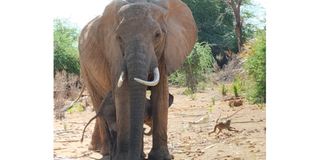The wildlife to see at Samburu Game Reserve

Mother elephant and calf under her in Samburu National Reserve. Photo | Rupi Mangat
What you need to know:
Today, there are fewer than 10 cheetahs in Samburu and Buffalo Springs due to human-wildlife conflict and climate change effects
The drive through Kalama Conservancy bordering the more famous Samburu National Reserve over the last five years shows the ravaging effects in Kenya’s northern scape. Save for the vibrant pink of the desert rose the land is dry with the wildlife surviving on the morning dew, the little water in the Ewaso Nyiro river and other adaptations to the arid lands over millennia - like the Beisa oryx, Grevy’s zebra, Reticulated giraffe, gerenuk and Somali ostrich with the males showing off their purple necks and legs. We see them on the drive up to the spectacular Saruni lodge set amidst ravishing rocks and stunning views of the northern mountains like Mount Kenya, the Mathews Range and the sacred Samburu massif shaped like a bread loaf – the iconic Ol Lolokwe.

Three cheetah siblings a year later in Samburu National Reserve. Photo | Rupi Mangat
“This is the highway to Saruni,” jokes Sumaro Lecharkole, our Samburu driver guide from Kalama Conservancy. The ‘highway’ is a steep drive up a gigantic copper-coloured rock. I think we may be reaching for the skies when suddenly we’re on flat terrain – but only for a moment.
The view from this vantage point is of another gigantic rock that fills the orb of the eye. I opt to scale it with the guide and as we get over the ridge, we’re at the lodge – Saruni – the only one in Kalama conservancy that belongs to the local Samburu.

Saruni in Kalama Conservancy in Samburu. Photo | Rupi Mangat
It’s divine. Every private villa shows off the vast plains below and the walk to and from the dining area builds an appetite for the gourmet platters at every meal.
Basking in the beauty of the camp, the complimentary massage is a treat before the game drive into Samburu National Reserve.
It’s here that the cheetah family shows itself – the same one in the same vicinity that we saw exactly a year ago in November 2021 when the cubs were just tiny fluff balls and so playful with the mother.
This time, I’m with Mary Wykstra, founder of Action for Cheetahs in Kenya (ACK) watching the spotted sphinx family stretch and limber up before strolling to the sand bank that offers a high point to scan for a possible hunt – there are a few gazelles browsing in the eventide but the tiny dikdiks –the cheetahs favourite prey – remain behind bushes.
A year ago, there were four cubs. Now we see two males with their sister acting so grown up.
“It’s so nice to see that the three cubs have been successfully reared by the mother cheetah in Samburu National Reserve,” states Wykstra. “This is a great addition to the cheetahs in this region.”
Keenly watching the cubs, Wykstra continues. “The mother cheetah was first seen in 2021 with four cubs and she remained in the park for over a year, seen often with her cubs in Samburu National Reserve and Buffalo Springs National Reserve. She navigated a landscape filled with lions, leopards and herders that have been inside the protected areas due to the current drought. Her ability to raise the cubs brings hope to a recovery of losses that happened in previous years.”
Samburu Wildlife
Today, there are fewer than 10 cheetahs in Samburu and Buffalo Springs. According to the cheetah researcher, the larger Laikipia-Samburu-Isiolo landscape had fewer than 300 cheetahs in 2007, but now there may be fewer than 200. Human-wildlife conflict, speeding vehicles on the tarmac roads, increase in human population and therefore habitat destruction are part of the reasons for their decline.
For more info on lions – find the information on ewasolions.org. The organisation was founded in 2007 for the protection of lions and people in northern Kenya.
Samburu Serenade
An hour’s flight or a six-hour drive will bring you to Saruni Samburu the six villa eco-lodge with unforgettable views of Mt. Kenya.
Or drive from Nairobi to Kalama Conservancy via Nanyuki and Isiolo: 330 kms or minimum 6 hours’ drive.
You need a sturdy 4-wheel drive or hire one. Carry your ID cards/passports for proof of residency.
It is a high-end lodge, so look out for the special offers for residents. There are campsites in the conservancy too.
Log on to Action for Cheetahs in Kenya for more on the fastest cat on earth.
Things to do at Saruni:
- Complimentary massages one person per tent.
- Night game drives
- Bush meals and cocktails with Samburu warriors showing dances of war, peace and rain.
- Visit Reteti Elephant Sanctuary the first Samburu-owned elephant sanctuary in Kenya.
- With more time: Travel further north to Turkana.




